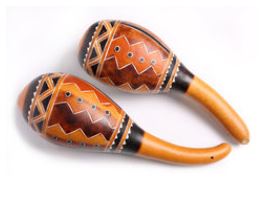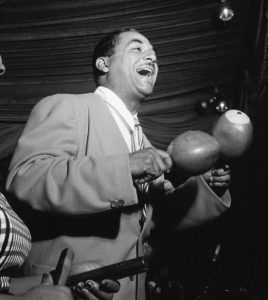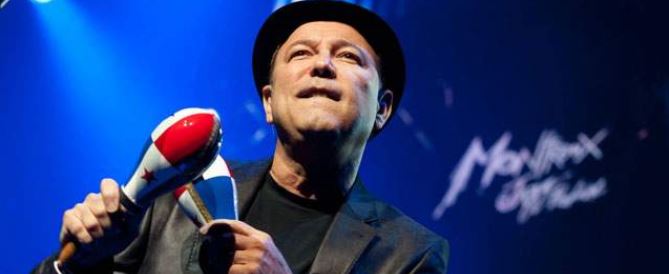This post is also available in:
 Español
Español
“Echale semilla a la maraca pa’ que suene; cha-cu-cha, cu-chu-cu cha cu-cha” said the recently departed Cheo Feliciano in his Fania All Stars version of “El Raton“, regarding the use of maracas.
Cheo Feliciano highlighted a simple but important instrument that is idiosyncratic of Latin music.
Our Latin American culture is made up of the mix of three races, Indigenous, Spaniard, and African. From Spain we got the guitars, from Africa the drums, and from Native Indians, one of the instruments we got was the maraca.
I am so grateful of the “maraca”, as it’s one of the few instruments I can play when I’ve gathered with friends to have some music-making fun. If you’ve been involved with friends in “parrandas”, “posadas”, “batucadas”, “rumbones” or any other form of musical gathering, the maracas, along with the “palitos” (clave) and guiros, are one of the simplest instruments to play. Hey, even babies get a maraca as one of the first toys to play with.
Origins of the Maracas

Most studies agree that the maraca came from the indigenous tribes in Latin America. What they don’t agree is on which tribe and in which country of Latin America they were first seen. I thought a simple instrument like maracas would be easy to trace its origins. I was mistaken!
Puerto Rico, Brazil, and Venezuela seem to be the top 3 countries that dispute the origins of the maracas.
In my research I found that the Arauca’s tribe from South America seems to be most closely linked to the creation of the maraca. Either them directly when stationed in what is now Brazil, or indirectly by fighting through South America. Eventually they caused the Taino tribe to move up the Lesser Antilles islands in the Caribbean. The Tainos made their way up to Puerto Rico. It turns out that another theory indicates this was the place where they created the maracas.
Before heading up through the Antilles islands towards Puerto Rico, the Tainos lived in Venezuela. There they could have invented the maracas as stated by another theory. But one thing is certain; either the Arauca’s or the Tainos invented the maracas.
The Maracas Instrument

The maraca is made from a tree fruit. In Puerto Rico, they are made from a native small tree called the “higuera”. This tree produces a fruit with a hard shell. The Tainos made a small hole in the shell to extract the pulp. Then, and after letting it dry, they would fill it with seeds or pebbles.
A wood stick is normally placed through the core of the maracas as a handle for them. It also serves to not interfere with the sound of its core. Nowadays, maracas are tied together with a string between the two wooden sticks. The main purpose of this is to keep them together and not lose one of the pair.
That’s why Cheo said “echale semilla a la maraca pa’ que suene”, in that Fania All Stars version of the song. The maracas are normally (but not always) played in pairs. The amount of seeds, pebbles, or whatever is used to make their sound, is normally not in equal amounts. One maraca will normally have more seeds than the other. This will have the effect of producing different pitches in their sound.
The modern day maraca is made of leather or plastic. Additionally, it’s filled with all kinds of materials to make their sound.
Use of the Maracas
The indigenous inhabitants of Latin America originally used the maraca in religious chants and ceremonies. They gave a vibrant sound that highlighted these ceremonies.
In the 19th and 20th century, the maraca was introduced to many rhythms that were developing in Latin America and the Caribbean. In Cuba they were adopted in the “son”, “guaracha”, and “danzon”. For these genres, they are used in pairs.
For Puerto Rican “bomba“, a single maraca is used, and one that is normally bigger in size than the ones used in pairs.
John Santos Demonstrates Use of Maracas in Latin Music (video)
In the video below, Latin music master percussionist John Santos demonstrates how maracas are used for different rhythms in Latin music.
Maracas Impact in Latin Music
You can see and hear the use of maracas in our folkloric music from various Latin American countries. The use of maracas spread widely through Latin America and beyond.
Salsa music lovers are very familiar with maracas. Salsa inherited the use of then from the Cuban “son”, “guaracha”, and “bolero”, which frequently used them.
Frank “Machito” Grillo was one of the most famous maraca players in Latin music. Since his music set a precedence for modern Salsa and Latin Jazz, the maracas are also prevalent in today’s Salsa music. However, today it is rare to see musicians that truly master this simple instrument. More maraca masters are found in folkloric music instead of those you see in Salsa or Afro-Cuban music.
I find the maraca to be an essential instrument in Latin music, and I’m grateful it’s a simple instrument that I can get to play with a certain level of decency when we have “parrandas” or “batucadas” with friends. It sure is fun to make noise with them!


Disculpa una pregunta. ¿Cuánto te pagan por esta clase
de artículos? Digo porque para lograrlo gratuitamente en serio
que flojera.
No me pagan. Lo hago porque me gusta la música y me gusta compartir lo que se.
What date was it invented
Hi Samuel,
The short answer is I don’t know. Since maracas were invented by the Taino tribes, and they didn’t keep written documents, its hard to know. However, doing some forensics on some of the remains found, scientists could probably provide a good date estimate. I didn’t find one in my research.
If you do come across that information, I would greatly appreciate if you share it.
Thanks,
Hector
[…] family, she wasted no time finding opportunities to sing. In the process she learned to play the maracas, clave, and mayor percussion of conga, bongo, and timbales. These instruments would amplify her […]
[…] the origins and history of Latin music genres. This includes the people, traditions, places, and instruments that made them flourish. In short, I enjoy writing about our Latin music […]
[…] you have a chance search for John Santos videos in YouTube. I featured one, in my blog “The Maracas Indigenous Origins“, where he explains the use of the […]